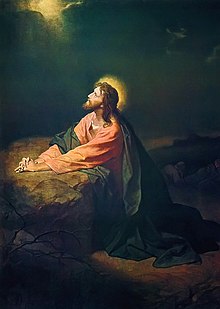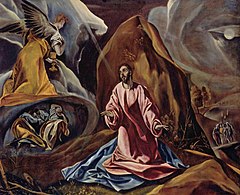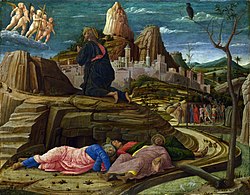|
Agony in the Garden
The Agony in the Garden of Gethsemane is an episode in the life of Jesus, which occurred after the Last Supper and before his betrayal and arrest, all part of the Passion of Jesus leading to his crucifixion and death. This episode is described in the three Synoptic Gospels in the New Testament.[1][2][3] According to these accounts, Jesus, accompanied by Peter, John and James, enters the garden of Gethsemane on the Mount of Olives where he experiences great anguish and prays to be delivered from his impending suffering, while also accepting God's will. This episode is a significant event in Christian tradition, especially in Catholic devotional practices. The agony of Jesus in the Garden is the first (or second) station of the Scriptural Way of the Cross (modern version of the Via Crucis) and the first "sorrowful mystery" of the Dominican Rosary, and it is the inspiration for the Holy Hour devotion in the Eucharistic adoration. It has been a frequent theme in Christian art depicting the life of Jesus. Gospel narratives According to the Synoptic Gospels, immediately after the Last Supper, Jesus retreated to a garden to pray. Each gospel offers a slightly different account regarding narrative details. The gospels of Matthew and Mark identify this place of prayer as Gethsemane. Jesus was accompanied by three Apostles: Peter, John and James, whom he asked to stay awake and pray. He moved "a stone's throw away" from them, where he felt overwhelming sadness and anguish, and said "My Father, if it is possible, let this cup pass me by. Nevertheless, let it be as You, not I, would have it." Then, a little while later, he said, "If this cup cannot pass by, but I must drink it, Your will be done!" (Matthew 26:42;[4] in Latin Vulgate: fiat voluntas tua)[5] He said this prayer thrice, checking on the three apostles after each prayer and finding them asleep. He commented: "The spirit is willing, but the flesh is weak". An angel came from heaven to strengthen him. During his agony as he prayed, "His sweat was, as it were, great drops of blood falling down upon the ground" (Luke 22:44).[6] At the conclusion of the narrative, Jesus accepts that the hour has come for him to be betrayed.[7] Tradition In Roman Catholic tradition, the Agony in the Garden is the first Sorrowful Mystery of the Rosary[8] and the First Station of the Scriptural Way of the Cross (second station in the Philippine version). Catholic tradition includes specific prayers and devotions. These Acts of Reparation to Jesus Christ do not involve a petition for a living or dead beneficiary, but aim to "repair the sins" against Jesus. Traditionally, prayers honoring the Agony in the Garden are most influential during the Holy Hour. Some such prayers are provided in the Raccolta Catholic prayer book (approved by a Decree of 1854, and published by the Holy See in 1898) which also includes prayers as Acts of Reparation to the Virgin Mary.[9][10][11] In his encyclical Miserentissimus Redemptor on reparations, Pope Pius XI called Acts of Reparation to Jesus Christ a duty for Catholics and referred to them as "some sort of compensation to be rendered for the injury" with respect to the sufferings of Jesus.[12] Catholic tradition holds that Jesus's sweating of blood was literal and not figurative.[13] Holy HourIn the Catholic tradition, Matthew 26:40[14] is the basis of the Holy Hour devotion for Eucharistic adoration.[15] In the Gospel of Matthew:
Coming to the disciples, He found them sleeping and, in Matthew 26:40, asked Peter: "So, could you not watch with Me one hour?"[15] The tradition of the Holy Hour devotion dates back to 1673 when Saint Margaret Mary Alacoque stated that she had a vision of Jesus in which she was instructed to spend an hour every Thursday night to meditate on the suffering of Jesus in the Garden of Gethsemane.[17][18][19] CommentaryMartin Pable, OFM Cap suggests that Jesus experienced fear, loneliness, and perhaps a sense of failure.[20] Justus Knecht gives three possible causes for Christ's sadness and agony:
Roger Baxter in his Meditations reflects on the angel comforting Christ, writing, "Good God! is it possible that the eternal Son of God should borrow comfort from His creatures? Observe how the Father of lights at last sends comfort to those who persevere in prayer. Imagine what reasons the angel might use in comforting your agonizing Saviour. He probably represented to Him the necessity of His passion for the redemption of mankind, and the glory that would redound to His Father and Himself. All this Christ understood infinitely better than the angel, yet He did not refuse the proffer of consolation, in order to teach you to respect the advice and consolation of your inferiors."[22] Artistic depictions There are a number of different depictions in art of the Agony in the Garden, including:
Medical conjecturesSome in the medical field have hypothesized that Jesus's great anguish caused him to experience hematidrosis (a medical term for sweating blood). In the traditional viewpoint (that Luke wrote the Gospel of Luke), it is believed that only Luke described Jesus as sweating blood because Luke was a physician.[24] See alsoFurther reading
ReferencesWikimedia Commons has media related to Agony in the Garden.
|
